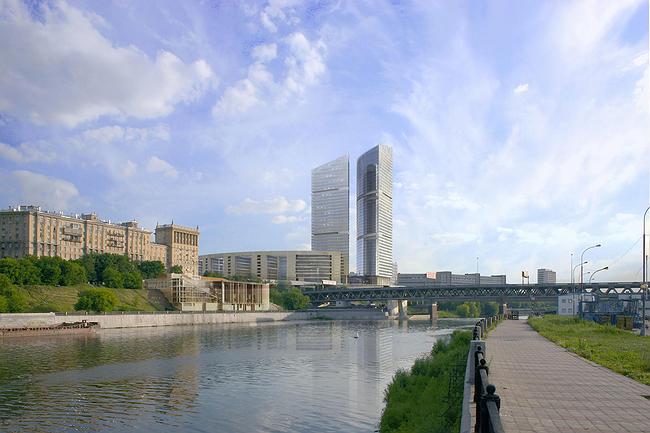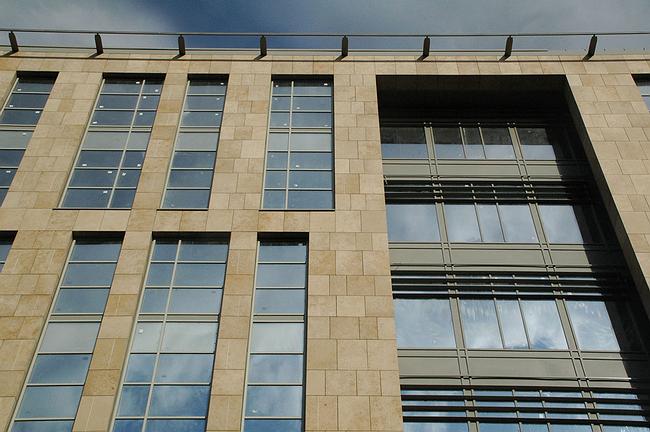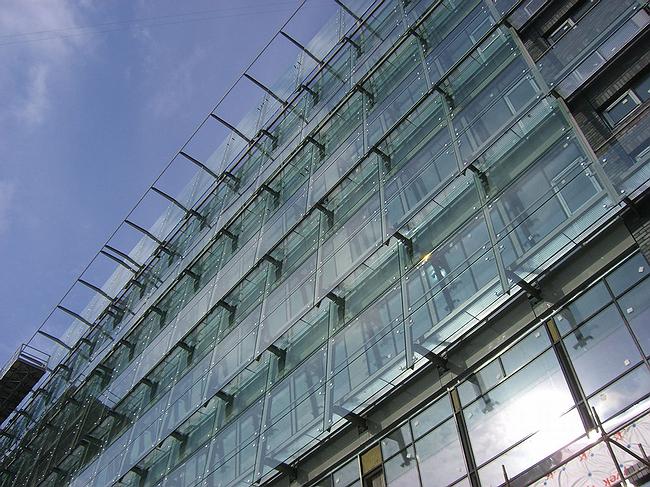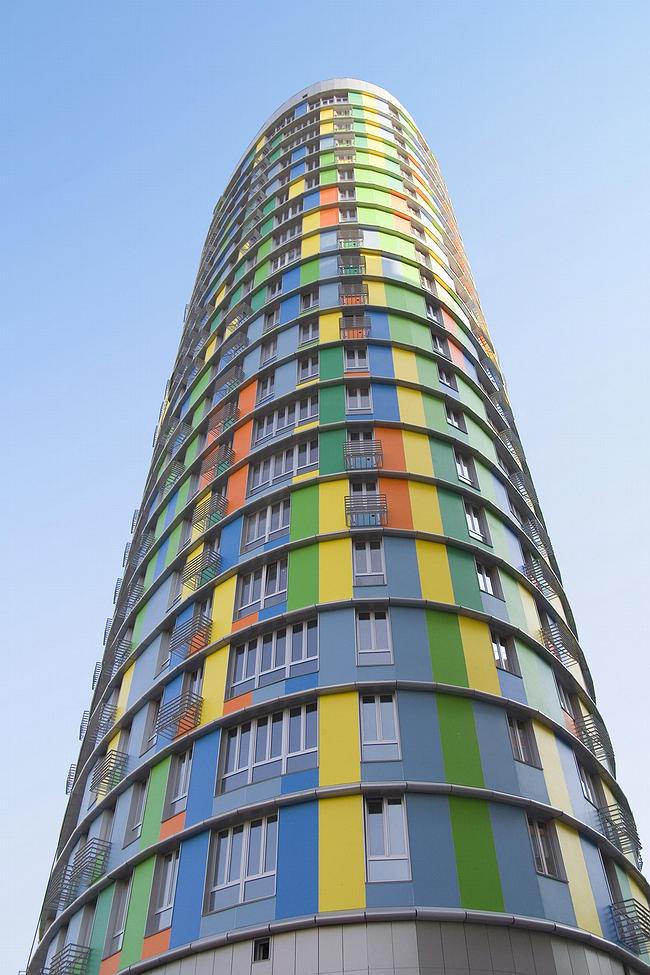An important factor was a trip to America made by the first delegation of Soviet architects to visit the USA since 1935. The party included: Yury Platonov, who had recently been elected Chairman of the Union of Architects ‘from the floor’; Aleksandr Kudryavtsev, Rector of the Moscow Institute of Architecture; Academician Dzhim Torosyan; and myself (representing the country’s young architects). We were literally given the red-carpet treatment from New York to San Francisco and received with great honour. This trip literally revolutionized my outlook on life. It was then that I met the architect Sydney Gilbert, who was Vice-chairman of Architects, Designers, and Planners for Social Responsibility, our host organization. This acquaintance had a great impact on me.
American architecture of that time really influenced you?
No, not architecture, but how the process was organized. Sydney was no ‘star’, and at the time the big names in architecture paid us Russians no attention. But he was a brilliant organizer. Everything in his office was beautifully arranged, and we subsequently used this experience in our own work. And the second important thing was that he brought us commissions. We organized a kind of exchange of delegations between our offices. Subsequently, we signed an agreement by which we undertook to work only with Gilbert’s firm in America and were in turn his only partner in Russia. He began supplying us with commissions to design Russian offices for foreign companies (it was at that time that they began setting up operations here). Mainly, this was interior design. It was a good start and it allowed us to gain experience. Then we stopped being interested in interior design, and in 1996 we passed all these contacts to Boris Levyant, who retains an interior-design department to this day.
So you started specializing?
Yes, in the end we specialized. Like many, though, we started with interiors, and did a great number of them. For the joint-stock enterprise Burda Moden alone – which at the end of the 1980s was curated by Raisa Gorbachev in person – we designed offices in Moscow and another 16 cities. Then in 1992 we did the urban-planning concept for the development of Mosfilmovsky district. The concept went before a session of the Government of Moscow. Subsequently, we had the heads of other municipal districts queuing at our doors, so to speak. This was followed by reconstruction and even restoration projects, including the restoration project for the Senate in the Kremlin. Then came contextual construction projects and restoration of historical buildings, including of the building which contains our office. At the time, in the mid 1990s, we invested our labour by doing several projects free of charge in exchange for the chance to have our own office in the city centre. Our logo still contains the words ‘architecture, design, planning’, implying that we are a large universal company. However, it’s now extremely rare for us to take on interior-design jobs, and only in buildings which we have designed ourselves. And ‘two-dimensional’ planning, i.e. urban planning, is something we’ve likewise not done for a long time, although Vyacheslav Bogachkin, one of my colleagues from the 90s, and I graduated from the Department of Urban Planning at MARCHI. We gradually realized that urban planning is another type of activity: it is management, zoning laws, and regulation. So, even though we design street blocks of 10-15 hectares, I don’t regard this as urban planning, but as building design on a large scale. Ours is ‘box’ architecture. We design only for the city. Single-family houses and out-of-town settlements are not our thing. In the final analysis, we specialize in large architectural objects that are financially independent from the authorities.
Why?
At the beginning of the 1990s we made an attempt to work for public money. The civil servant who was responsible for allocating the commission suggested that we return to him part of the money for this commission. We thought him a thief, turned the job down, and decided, as far as possible, to have nothing more to do with such officials. We decided we should work with people who have their own money or borrow it, rather than for public money.
Have you had any desire to change or expand your established area of specialization?
I have said repeatedly that we’re a little tired of commercial commissions. Of course, we want to do non-commercial architecture – or, at the very least, architecture that prioritizes image. Currently, what we mainly do is satisfy the client’s objectives, and clients usually want the maximum – to spend as little as possible on construction and sell for as high a price as possible. We would like to design a building with a cultural function – one where profit is not the main criterion of success. But no one has approached us with such a proposal. Probably, we’re too dry, too far from art. Perhaps it’s in vain that we have created this image for ourselves, refraining from emphasizing the aesthetic aspects of our work for fear of being told that we won’t be able to cope. Perhaps this is from fright. Unjustified fright.
Nonetheless, in 2007 you were named ‘Architect of the Year’ at Arch Moscow and, what’s more, picked up all possible awards for best buildings for the same year.
I was surprised when we were honoured as best architects. When we were awarded the prize for best project from the point of view of developers for Avant-garde a year earlier, that was more comprehensible.
You often talk in this vein – emphasizing the pragmatic side of things while leaving aesthetics to art critics. At the same time your work clearly shows rules and principles – with regard to both style and behaviour – to which you adhere quite strictly. Could you say a few words about these principles?
There are two of them and they both begin with ‘u’ in Russian – appropriateness and ability. Appropriateness means ‘don’t harm’ the site or the city. It’s the social responsibility that the architect should feel with respect to the city in which he works. And ability is that which makes it possible for architects to satisfy their clients’ requirements.
But these are opposites: everything for the city and everything for the client!
Yes, and there’s a third principle: compromise, the ability to find a balance between the above two principles. My ‘sworn friends’ are often ironic on this subject. Kiselev, they say, can find his way between the raindrops; he’s an affectionate calf sucking two mothers. But I’m absolutely sure that an urban architect should have a talent for finding a compromise between the greed of the client and the constraints imposed by the city. The better the balance he can find, the better the buildings that he designs for the city. The ability to reach agreement, to explain why certain things cannot be done, to satisfy the client materially and spiritually, and at the same time not to behave offensively in the city: these have been the main principles that have governed us when building in the historical city centre. Currently, we’re trying to do exactly the same in our large projects, but they are on a different level of technical complexity. Here a different philosophy and different aesthetic apply: you have to create an absolutely rational building. This in itself entails an aesthetic component.
What do you mean by rationalism?
Nothing should happen without good reason. As a student, I read a textbook on formal logic for teaching colleges. I really liked it. It made clear that everything flows from and follows something else. This makes it difficult for me to accept from my colleagues arguments such as ‘That’s the way I see it’. There have even been conflicts, and gradually we’ve been left only with architects who can explain their decisions and formulate why they have drawn something this way and no other – why there’s a projection here, why green is the colour used here and red the colour here. This can be difficult; solutions occur intuitively, but at the same time I think it very important to think through the result, to make it well-considered – rather than an automatic movement of the hand. Architecture, as I see it, is a more complex species of activity than simply art. It involves organizing life, functions, flows, and movements of people and vehicles. Note that in Vitruvius’s triad of ‘benefit, strength, beauty’, beauty comes last. A great many of my colleagues and many art critics read this triad in reverse order, emphasizing the aesthetic component. There’s reason for this: art is higher and it’s art that moves culture forwards. The two other components are self-evident. But I think it’s very important in the city to see the other components as well as the aesthetic. A city is something more complex than simply the sum of its buildings. It’s an organism that has to be managed. Its processes need to be organized by means of laws and rules, written and unwritten. For me, for example, the environment as a whole is very important – the potholes on the roads, advertising banners strung across houses, and dirty rubbish bins. Not to mention the crumbling facades.
You have created a large architectural firm with a large number of projects and several leading architects. At the same time, your scrupulousness is well-known: some time ago, you even refrained from having your surname necessarily put first in the list of members of the creative team – so as to show the degree to which you had taken part in a project. Why?
There are traditions and rules of decency. At a certain moment there gets to be so much work and so many helpers are involved that it becomes more their project than yours. In general, having a project in production is awful. It ought to be your project, but you’ve lost control of it, and it becomes more someone else’s than yours. So I refrained from putting my own surname first on buildings which seemed to me to have been conceived by other people. This concerned Skuratov and Bogachkin, above all. They were self-sufficient. These guys have set up their own offices and now have every right to put their names at the top. At the same time, my ‘complexes’ in this regard have been largely eliminated by a whole series of buildings which have likewise won acclaim and in which the main melody and idea have been mine. They are: the oval block in the Central Telegraph project, Subaru Centre, Avantgarde, Ermitazh Plaza, and other structures where it was I who determined the main principles. In the case of Avantgarde I proposed making the building multihued, of three types of panels, proposed correcting the tension in the lines of its rounded outline, and proposed putting it on legs like a cupboard… On the other hand, in large foreign companies it’s accepted procedure for the owner always to write his name first. It’s like the artistic director of a theatre – who may not direct every production, but nevertheless determines the main themes. We espouse certain aesthetic principles. It’s unlikely, for instance, that something decorated with capitals will ever come out of this office.
You don’t do Classicism. To design the Neoclassical house in Levshinsky pereulok, you called on Il’ya Utkin. What else defines your aesthetics?
As Okuzhava said, ‘everyone writes as he breathes.’ I’m of the firm opinion that all architecture is a portrait not just of its author, but also of the age and the country in which it is created. A civilization should be reflected in architecture that matches its degree of progress. If the idea of appropriateness is extended to include position in time, then I sincerely think that Classical architecture is absolutely inappropriate when we have other technical capabilities, another language, and another mentality. There are, of course, specific tasks that make it necessary to use traditional techniques, but this is mainly for restoration work.
So for you Classicism is conservatism?
Yes. It goes without saying that the different types of architecture may be talented or the reverse, but still I think it strange to create Classical architecture in this day and age. It’s something I just cannot understand.
To return to principles, what was your motivation in leaving design institute in the 1980s to set up your own architectural office?
First, there is such a thing as honesty. It is impossible to sit for eight hours a day earning 150 rubles and then earn 800 during the evenings. It just doesn’t make sense. Clearly, your main working day will be less intense and you’ll begin using these less busy eight hours to do what you should be doing in the evening after work. This is one such principle. There was another interesting point, though. I had always been apolitical and even took pride in the fact that till the age of 27 I hadn’t even read the Komsomol charter. Then I was invited to join the Communist Party. I categorically refused until Yury Platonov, who had become a member of the Party’s Central Committee, talked me into it by arguing that as Communists we should reconstruct the country. I joined, but then, as soon as I realized I’d made a mistake, I quickly left of my own accord. You could say these were acts of the same order – to leave the Party and to resign from design institute. This was in the spring of 1988. At the time this was a serious matter: I was taken aside and asked how I’d dare return my Party membership card.
All for the sake of being honest?
Strictly speaking, yes. There are colleagues of mine of whom it’s said at planning-approval sessions, for instance, that their figures need to be checked. Whereas my figures never have to be checked. Reputation is the most valuable capital there is; this is our slogan to this day.
Is this a help or a hindrance?
A help. I think this was wise – to stake our money on reputation from the very beginning. This is our principle, you could say. Why was I awarded ‘Architect of the Year’? I really don’t know! I suppose that over the years we have earned ourselves a reputation which has led both the architectural authorities and clients to think highly of us. Judging by the number of commissions we have, our reputation is well-deserved. Now it works in our favour, and all we have to do is maintain it.









































